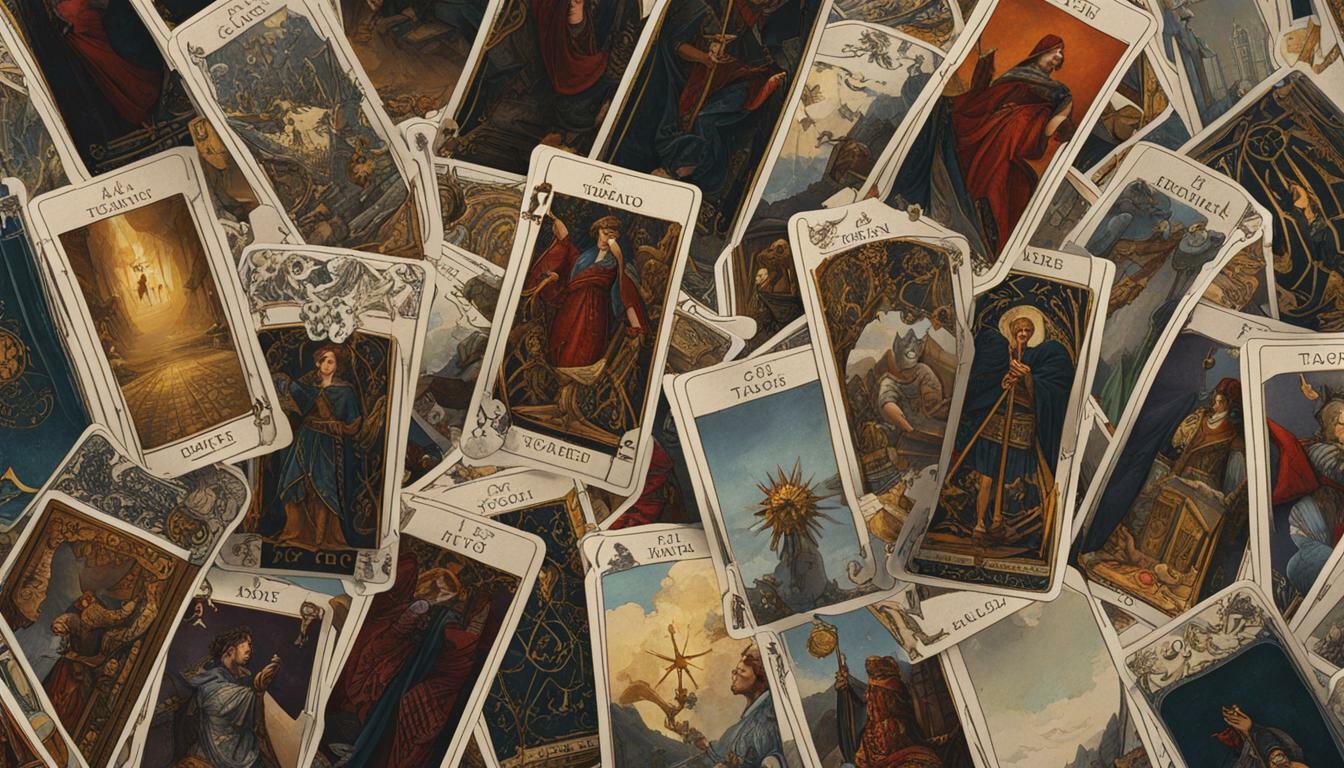When it comes to decoding tarot cards, one common question arises: how many cards should you pull for a tarot reading? Understanding the different categories and meanings of tarot cards is crucial in determining the optimal number of cards to pull. A standard tarot deck consists of 78 cards, divided into Major Arcana and Minor Arcana.
The Major Arcana cards, including the Fool and 21 numbered cards, represent significant life lessons. On the other hand, the Minor Arcana cards relate to the specific challenges and energies of daily life. The Minor Arcana is further divided into four suits – Wands, Cups, Swords, and Pentacles – each with its own symbolism and significance. These categories provide a framework for interpreting the cards and gaining deeper insights.
Key Takeaways:
- Understanding the different categories of tarot cards is essential in determining the optimal number of cards to pull for a reading.
- A standard tarot deck consists of 78 cards, divided into Major Arcana and Minor Arcana, each with its own meanings and symbolism.
- The Major Arcana cards represent significant life lessons, while the Minor Arcana cards relate to daily challenges and energies.
- The number of cards to pull for a reading can vary depending on the depth and focus of the reading.
- A single card can be pulled for a simple reading, while spreads, which use multiple cards, provide a broader understanding of the situation or life path.
Understanding the Different Categories of Tarot Cards
Before we explore the optimal number of cards to pull for a tarot reading, it’s important to understand the different categories of tarot cards. A standard tarot deck consists of 78 cards, divided into Major Arcana and Minor Arcana.
| Category | Description |
|---|---|
| Major Arcana | The Major Arcana cards represent significant life lessons. They include the Fool and 21 numbered cards, each with its own symbolism and meaning. |
| Minor Arcana | The Minor Arcana cards relate to the specific challenges and energies of daily life. They are divided into four suits: |
|
Understanding the different categories of tarot cards allows you to interpret their meanings and messages more effectively. Each card carries its own unique energy and symbolism, and knowing which category it belongs to helps you gain a deeper insight into your readings.
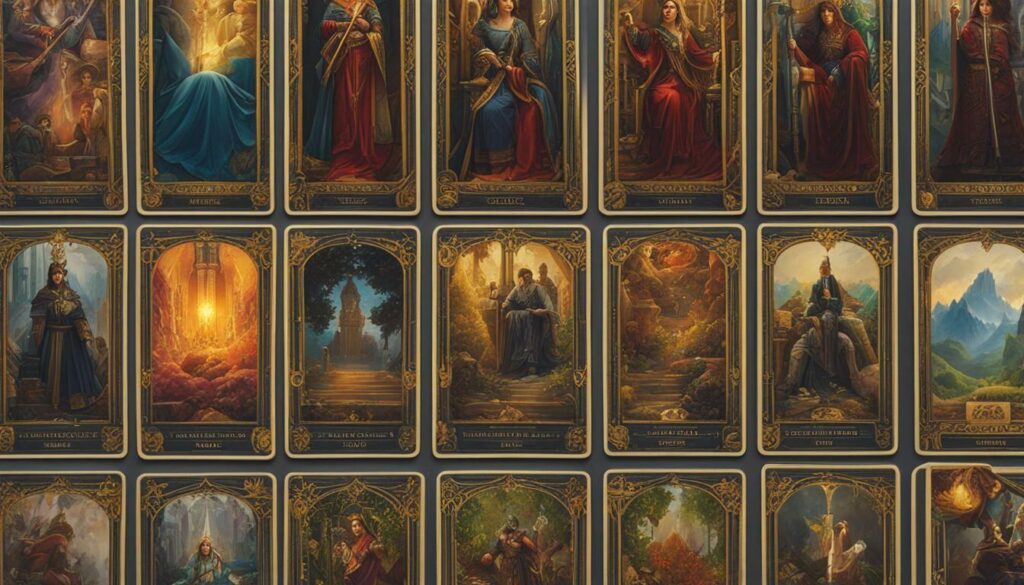
When conducting a tarot reading, the selection of cards plays a crucial role in providing accurate guidance and clarity. The combination of Major Arcana and Minor Arcana cards brings balance and depth to the reading, allowing you to explore both the broader life lessons and the specific challenges you may be facing.
Choosing the right amount of cards for your tarot reading
The number of cards you pull for a tarot reading can vary depending on the depth of the reading and the questions you seek answers to. For a simple reading, pulling a single card can provide concise guidance and insight. This is especially helpful when you need a quick answer or when you seek clarity on a specific situation.
However, for more comprehensive readings that offer a broader understanding of your situation or life path, using spreads with multiple cards is recommended. Popular tarot spreads like the three-card spread or the five-card spread can shed light on past influences, current challenges, and future possibilities.
Experiment with different spreads and card quantities to find what works best for you and the type of guidance you seek. Remember, tarot readings are a personal and intuitive practice, and the most important thing is to trust your own instincts and connection with the cards.
| Tarot Spread | Purpose |
|---|---|
| Three-Card Spread | Offers insight into past, present, and future influences. |
| Five-Card Spread | Provides illumination and clarity on a specific situation or life path. |
Varying the Number of Cards for Different Readings
The number of cards you pull for a tarot reading can vary depending on the level of insight and understanding you seek. Whether you’re looking for a quick snapshot or a more in-depth analysis, choosing the right number of cards is key to getting the most out of your tarot reading.
For a simple reading that provides a general overview or guidance on a specific question, pulling a single card can be sufficient. This approach allows you to focus on one specific aspect of your life or the situation at hand. It’s like having a direct conversation with the cards, seeking clarity and guidance from a single source.
On the other hand, if you’re looking for a more comprehensive understanding of a situation or seeking guidance on multiple areas of your life, using spreads can be beneficial. Spreads involve pulling multiple cards and arranging them in specific positions, each representing different aspects of your life. Popular spreads like the three-card spread and the five-card spread can provide a more detailed analysis and offer insights into various facets of your life, such as love, career, and personal growth.
Popular Tarot Spreads
| Spread Name | Purpose |
|---|---|
| Three-card spread | Centering yourself during chaotic experiences |
| Five-card spread | Illumination and clarity |
Remember, the number of cards you pull is not set in stone. You can always adapt and customize your approach based on your specific needs. Trust your intuition and experiment with different card numbers and spreads to find what resonates with you the most.
By varying the number of cards, you can uncover deeper insights, gain a broader perspective, and find guidance in your tarot readings. Whether it’s a single card or a multi-card spread, each approach offers its own unique benefits. So go ahead, shuffle your deck, and start exploring the mysteries and wisdom that lie within the cards.
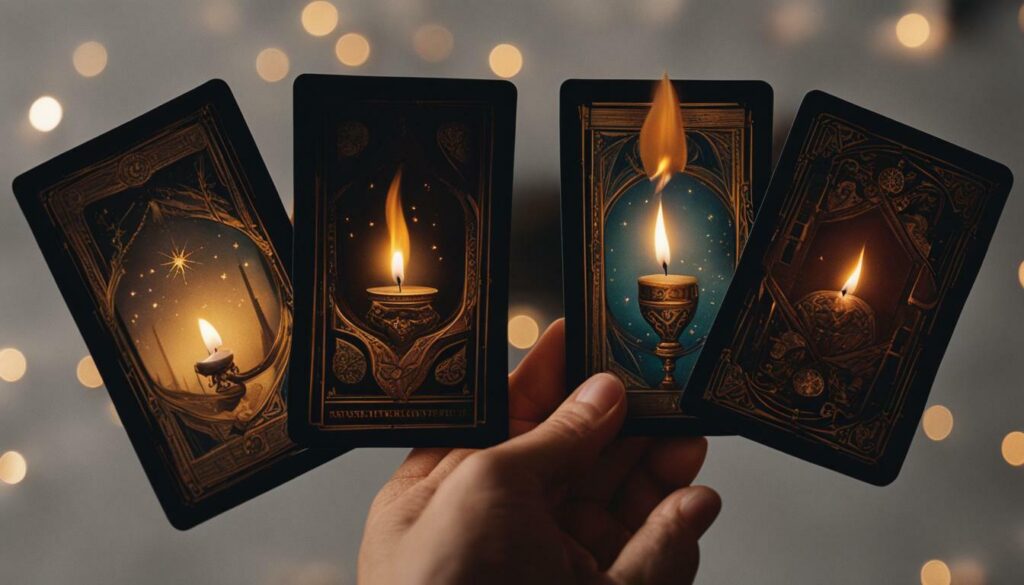
Asking Clear and Open-Ended Questions
To get the most out of your tarot reading, it’s crucial to ask clear and open-ended questions that promote exploration and self-reflection. By doing so, you allow the cards to provide guidance and insight into your unique situation and help you gain a deeper understanding of yourself and your path.
When formulating your questions, avoid ones that limit you to a passive role in the future. Instead, focus on broader inquiries that encourage you to take an active role in shaping your destiny. For example, instead of asking, “Will I find love?”, you could ask, “What can I do to attract love into my life?” This empowers you to take actionable steps towards manifesting your desires.
Techniques for Shuffling and Pulling Cards
Once you have formulated your questions, it’s time to shuffle and pull the cards. There are various methods for shuffling, such as the classic overhand shuffle or the more intuitive riffle shuffle. Choose a technique that feels comfortable and natural to you, as this will enhance your connection with the cards and the energy they carry.
When pulling cards, there are different spreads you can use based on the depth and focus of your reading. The three-card spread is perfect for gaining insight into a specific situation or seeking guidance during chaotic times. On the other hand, the five-card spread offers a broader perspective, shedding light on various aspects of your life and helping you gain clarity and direction.
To illustrate the power of tarot readings, consider this quote from renowned tarot reader Rachel Pollack: “Tarot cards are like people. We get to know them slowly, discovering their different sides and their many moods.” Just as we form relationships with people over time, developing a personal connection with the cards through regular use and reflection is key to unlocking their insights and wisdom.
Finally, remember that tarot readings are an intuitive process, and interpretation is subjective. Trust your intuition and rely on your own knowledge and experience to guide you in deciphering the messages of the cards. Tarot reading is a powerful tool for self-reflection, guidance, and personal growth, allowing you to make empowered choices and embark on a journey of self-discovery.
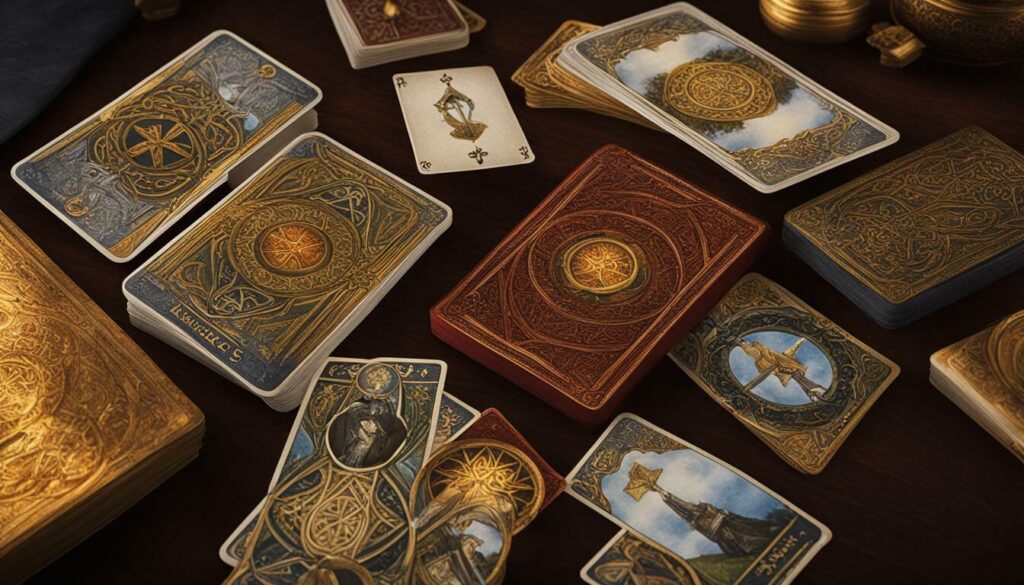
Establishing a Personal Relationship with the Cards
Building a personal relationship with your tarot cards is a powerful way to deepen your understanding and intuition. By connecting with your deck on a personal level, you can enhance the accuracy and insightfulness of your readings. One way to establish this connection is through journaling. Take a few moments each day to pull a card and reflect on its meaning. Write down your thoughts, feelings, and impressions in a dedicated tarot journal. This practice allows you to develop a deeper relationship with each card and uncover personal interpretations that resonate with you.
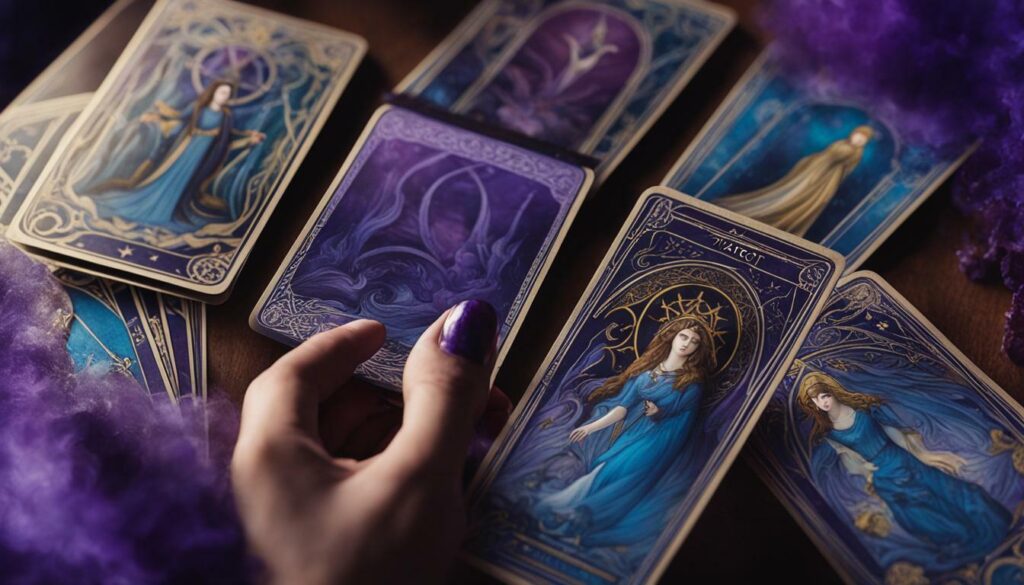
Another effective method is to incorporate tarot into your regular spiritual or self-care practice. Whether it’s a daily meditation with a card, a weekly reading for guidance, or a monthly spread to gain insight into the upcoming month, setting aside dedicated time for tarot will strengthen your bond with the cards. Consistency is key in building this relationship, so find a practice that works for you and commit to it.
As you develop your bond with the tarot cards, pay attention to your intuition. Trust your gut feelings and let them guide your interpretations. While traditional meanings and symbolism are valuable, always listen to your inner voice when interpreting the cards. Your personal relationship with the cards will bring unique insights and perspectives to your readings.
Remember:
- Journaling daily card pulls can deepen your understanding and intuition.
- Incorporating tarot into a regular practice strengthens your bond with the cards.
- Trust your intuition and let it guide your interpretations.
By establishing a personal relationship with your tarot cards, you unlock the full potential of their wisdom and guidance. Embrace the journey of self-discovery and empowerment that tarot can offer.
The Interpretation and Context of Tarot Readings
The interpretation of tarot cards is a subjective process that depends on the reader’s intuition and the specific context of the reading. Each card in the tarot deck carries its own symbolism and meaning, but it is up to the reader to interpret these symbols and apply them to the querent’s situation.
When conducting a tarot reading, it’s essential to consider the surrounding cards and their relationships with each other. The placement and proximity of the cards within a spread can influence their interpretation and provide deeper insights into the querent’s questions or concerns.
By examining the cards holistically, tarot readers can uncover patterns, themes, and overarching messages. They can also draw connections between the cards, their positions, and the querent’s personal circumstances, allowing for a more meaningful and accurate reading.
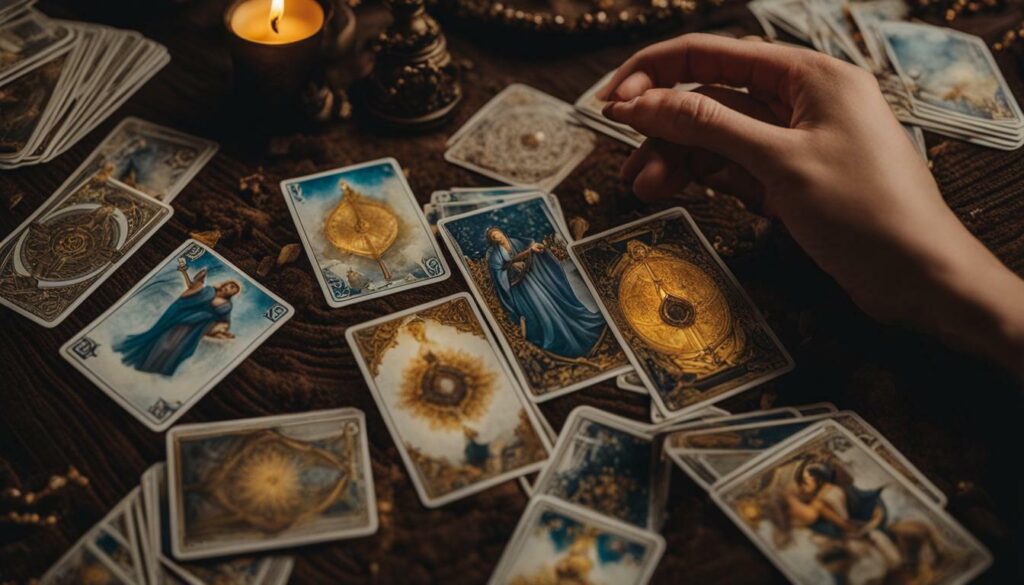
For example, if a querent asks about their love life and the Two of Cups, which represents harmony and partnership, appears alongside the Lovers card, it suggests that a significant romantic relationship may be on the horizon. On the other hand, if the Five of Cups, which symbolizes loss and disappointment, shows up in the same spread, it could indicate past heartbreak or unresolved emotional issues that need to be addressed before a new relationship can flourish.
The interpretation of tarot readings is deeply personal and can vary from reader to reader. It is influenced by their knowledge of the cards, their intuitive abilities, and their connection with the querent. Therefore, it is important for tarot readers to continually hone their skills, expand their knowledge, and trust their intuition to deliver accurate and insightful readings.
Tarot Readings: Clarity and Empowered Choices
Tarot readings offer clarity and support, empowering individuals to make choices aligned with their true selves. When decoding tarot cards, it’s important to understand the different categories and meanings of the cards. A standard tarot deck consists of 78 cards, divided into Major Arcana and Minor Arcana. The Major Arcana cards, which include the Fool and 21 numbered cards, represent significant life lessons. The Minor Arcana cards, on the other hand, relate to the specific challenges and energies of daily life. The Minor Arcana is further divided into four suits – Wands (passion and creativity), Cups (emotions and intuition), Swords (thoughts and actions), and Pentacles (material world and finances).
To conduct a tarot reading, the number of cards you pull can vary depending on the depth of the reading. You can pull a single card for a simple reading or use multiple cards for a spread, which provides a broader understanding of your situation or life path. Some popular spreads include the three-card spread for centering yourself during chaotic experiences and the five-card spread for illumination and clarity.
When pulling cards, it’s important to ask clear and open-ended questions. Avoid questions that lock you into a passive role in your future and instead ask broader questions that provide guidance and reflection. There are different techniques for shuffling and pulling cards, and it’s recommended to find a method that feels right for you.
To establish a personal relationship with the cards and deepen your understanding, it’s helpful to journal your daily pulls and reflect on your thoughts and feelings about each card. Additionally, incorporating tarot into a daily, weekly, or monthly practice can help you develop your intuitive abilities and tap into your inner wisdom.
Tarot cards can provide insight and guidance, but they don’t predict the future. The interpretation of the cards is subjective and dependent on the reader’s intuition and the specific context of the reading. Reversals, when cards are pulled upside down, can offer additional layers of meaning, although some tarot readers choose not to read reversals. Cleansing your cards regularly is also important to maintain their energy and accuracy. Ultimately, tarot reading is a personal and intuitive process that can help you gain clarity and make empowered choices in your life.
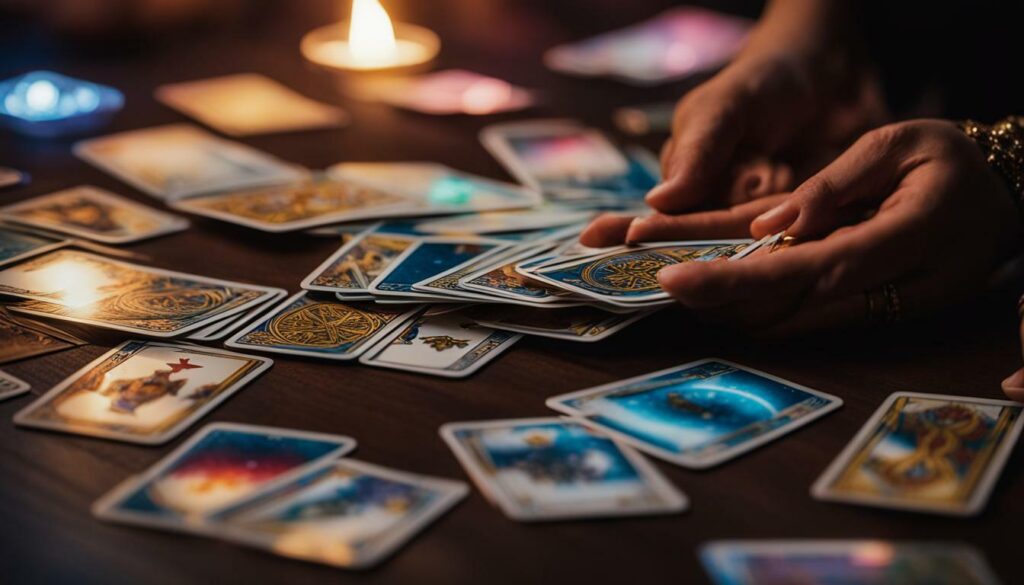
Conclusion
Tarot readings are a personal and intuitive process that can provide valuable insight and guidance for making empowered choices in life. When decoding tarot cards, it’s important to understand the different categories and meanings of the cards. A standard tarot deck consists of 78 cards, divided into Major Arcana and Minor Arcana. The Major Arcana cards, which include the Fool and 21 numbered cards, represent significant life lessons. The Minor Arcana cards, on the other hand, relate to the specific challenges and energies of daily life. The Minor Arcana is further divided into four suits – Wands (passion and creativity), Cups (emotions and intuition), Swords (thoughts and actions), and Pentacles (material world and finances).
When conducting a tarot reading, the number of cards you pull can vary depending on the depth of the reading. You can pull a single card for a simple reading or use multiple cards for a spread, which provides a broader understanding of your situation or life path. Some popular spreads include the three-card spread for centering yourself during chaotic experiences and the five-card spread for illumination and clarity.
When pulling cards, it’s important to ask clear and open-ended questions. Avoid questions that lock you into a passive role in your future and instead ask broader questions that provide guidance and reflection. There are different techniques for shuffling and pulling cards, and it’s recommended to find a method that feels right for you.
To establish a personal relationship with the cards and deepen your understanding, it’s helpful to journal your daily pulls and reflect on your thoughts and feelings about each card. Additionally, incorporating tarot into a daily, weekly, or monthly practice can help you develop your intuitive abilities and tap into your inner wisdom.
Tarot cards can provide insight and guidance, but they don’t predict the future. The interpretation of the cards is subjective and dependent on the reader’s intuition and the specific context of the reading. Reversals, when cards are pulled upside down, can offer additional layers of meaning, although some tarot readers choose not to read reversals. Cleansing your cards regularly is also important to maintain their energy and accuracy. Ultimately, tarot reading is a personal and intuitive process that can help you gain clarity and make empowered choices in your life.
FAQ
Q: How many cards should you pull for a tarot reading?
A: The number of cards you pull for a tarot reading can vary depending on the depth of the reading. You can pull a single card for a simple reading or use multiple cards for a spread, which provides a broader understanding of your situation or life path.
Q: What are the different categories of tarot cards?
A: A standard tarot deck consists of 78 cards divided into Major Arcana and Minor Arcana. The Major Arcana cards represent significant life lessons, while the Minor Arcana cards relate to specific challenges and energies of daily life. The Minor Arcana is further divided into four suits – Wands, Cups, Swords, and Pentacles – each with its own symbolism and significance.
Q: How can I vary the number of cards for different tarot readings?
A: The number of cards you pull for a tarot reading can vary depending on the depth and focus of the reading. You can pull a single card for a simple reading or use multiple cards for spreads like the three-card spread or the five-card spread, which provide a broader understanding of your situation or life path.
Q: How should I ask questions during a tarot reading?
A: When conducting a tarot reading, it’s important to ask clear and open-ended questions. Avoid questions that lock you into a passive role in your future and instead ask broader questions that provide guidance and reflection. This helps in gaining deeper insights and intuitive guidance.
Q: How can I establish a personal relationship with the tarot cards?
A: To establish a personal relationship with the tarot cards, it’s helpful to journal your daily card pulls and reflect on your thoughts and feelings about each card. Additionally, incorporating tarot into a daily, weekly, or monthly practice can help you develop your intuitive abilities and tap into your inner wisdom.
Q: What is the interpretation and context of tarot readings?
A: Tarot cards do not predict the future, but they provide insight and guidance. The interpretation of the cards is subjective and dependent on the reader’s intuition and the specific context of the reading. Reversals, when cards are pulled upside down, can offer additional layers of meaning, although not all tarot readers choose to read reversals. It’s recommended to cleanse your cards regularly to maintain their energy and accuracy.
Q: What role do tarot readings play in making choices?
A: Tarot readings provide clarity and empower individuals to make informed choices in their lives. They should not be seen as a definitive answer, but rather as a tool for self-reflection and guidance. Trusting your intuition and using tarot as a means of tapping into your inner wisdom can help you make empowered choices.
